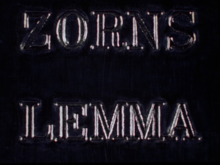Zorns Lemma (film)
| Zorns Lemma | |
|---|---|

Title screen
|
|
| Directed by | Hollis Frampton |
| Starring |
Joyce Wieland Robert Huot Marcia Steinbrecher |
|
Release date
|
|
|
Running time
|
60 minutes |
| Country | United States |
| Language | English |
Zorns Lemma is a 1970 American structural experimental film by Hollis Frampton. Originally starting as a series of photographs, the non-narrative film is structured around a 24-letter Latin alphabet. It remains, along with Michael Snow's Wavelength and Tony Conrad's The Flicker, one of the best known examples of structural filmmaking.
The opening section of Zorns Lemma is 5 minutes long. In it a woman reads an abecedary of 24 couplets from The Bay State Primer, an eighteenth century book designed to teach children the alphabet. The film is entirely black during this section.
The film's main section is silent and lasts 45 minutes, broken into 2,700 one-second units. It shows the viewer an evolving 24-part "alphabet". The section begins by presenting each letter typed on a sheet of tin foil. The alphabet is initially composed of words that appear on street signs, photographed in Manhattan. As the film continues to cycle through the alphabet, individual letters are slowly substituted with images. The first four substitutions—fire (x), waves (z), smoke (q), and reeds (y)–depict the four classical elements.
The film's conclusion lasts 10 minutes. It shows a man, woman and dog walking through snow. During this scene, six women's voices alternate in reading the words of a passage from On Light, or the Ingression of Forms by Robert Grosseteste. The voices read at a rate of one word per second.
Zorns Lemma emerged from Word Pictures, a photography project that Frampton made from 1962 to 1963. For Word Pictures, Frampton shot over 2000 black-and-white 35mm photographs of environmental words, seeking to explore the illusions of photography as a medium. However, he had difficulty devising a form in which to present the photographs. During this period, Frampton became less active as a photographer and first started to experiment with filmmaking. He started to make a film by shooting the photographs on a stand but thought the result looked "dead", deciding that he should film the words in color. He began filming static shots of words, carefully framing them with the use of a tripod.
...
Wikipedia
